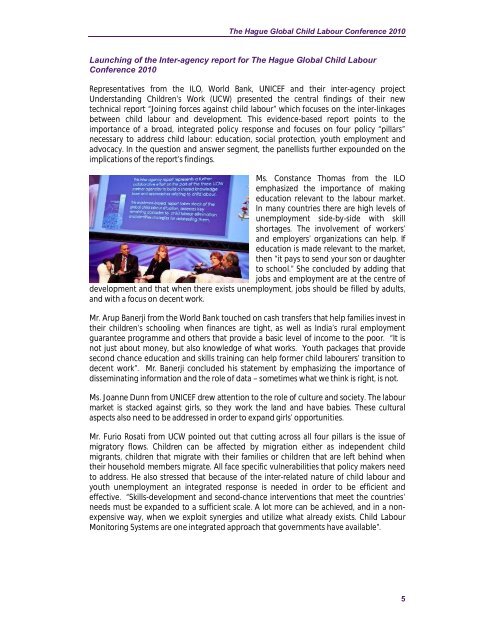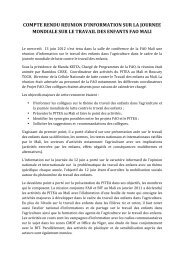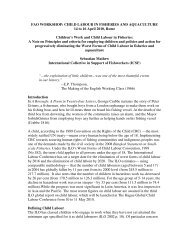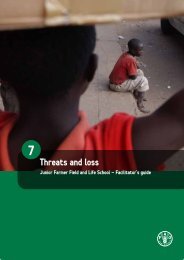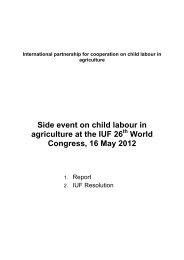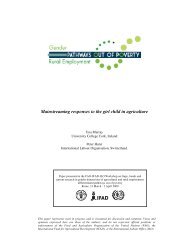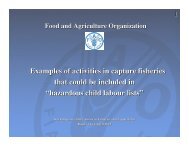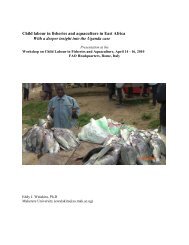The Hague Global Child Labour Conference 2010 - Food ...
The Hague Global Child Labour Conference 2010 - Food ...
The Hague Global Child Labour Conference 2010 - Food ...
Create successful ePaper yourself
Turn your PDF publications into a flip-book with our unique Google optimized e-Paper software.
<strong>The</strong> <strong>Hague</strong> <strong>Global</strong> <strong>Child</strong> <strong>Labour</strong> <strong>Conference</strong> <strong>2010</strong>Launching of the Inter-agency report for <strong>The</strong> <strong>Hague</strong> <strong>Global</strong> <strong>Child</strong> <strong>Labour</strong><strong>Conference</strong> <strong>2010</strong>Representatives from the ILO, World Bank, UNICEF and their inter-agency projectUnderstanding <strong>Child</strong>ren’s Work (UCW) presented the central findings of their newtechnical report “Joining forces against child labour” which focuses on the inter-linkagesbetween child labour and development. This evidence-based report points to theimportance of a broad, integrated policy response and focuses on four policy “pillars”necessary to address child labour: education, social protection, youth employment andadvocacy. In the question and answer segment, the panellists further expounded on theimplications of the report’s findings.Ms. Constance Thomas from the ILOemphasized the importance of makingeducation relevant to the labour market.In many countries there are high levels ofunemployment side-by-side with skillshortages. <strong>The</strong> involvement of workers’and employers’ organizations can help. Ifeducation is made relevant to the market,then “it pays to send your son or daughterto school.” She concluded by adding thatjobs and employment are at the centre ofdevelopment and that when there exists unemployment, jobs should be filled by adults,and with a focus on decent work.Mr. Arup Banerji from the World Bank touched on cash transfers that help families invest intheir children’s schooling when finances are tight, as well as India’s rural employmentguarantee programme and others that provide a basic level of income to the poor. “It isnot just about money, but also knowledge of what works. Youth packages that providesecond chance education and skills training can help former child labourers’ transition todecent work”. Mr. Banerji concluded his statement by emphasizing the importance ofdisseminating information and the role of data – sometimes what we think is right, is not.Ms. Joanne Dunn from UNICEF drew attention to the role of culture and society. <strong>The</strong> labourmarket is stacked against girls, so they work the land and have babies. <strong>The</strong>se culturalaspects also need to be addressed in order to expand girls’ opportunities.Mr. Furio Rosati from UCW pointed out that cutting across all four pillars is the issue ofmigratory flows. <strong>Child</strong>ren can be affected by migration either as independent childmigrants, children that migrate with their families or children that are left behind whentheir household members migrate. All face specific vulnerabilities that policy makers needto address. He also stressed that because of the inter-related nature of child labour andyouth unemployment an integrated response is needed in order to be efficient andeffective. “Skills-development and second-chance interventions that meet the countries’needs must be expanded to a sufficient scale. A lot more can be achieved, and in a nonexpensiveway, when we exploit synergies and utilize what already exists. <strong>Child</strong> <strong>Labour</strong>Monitoring Systems are one integrated approach that governments have available”.5


